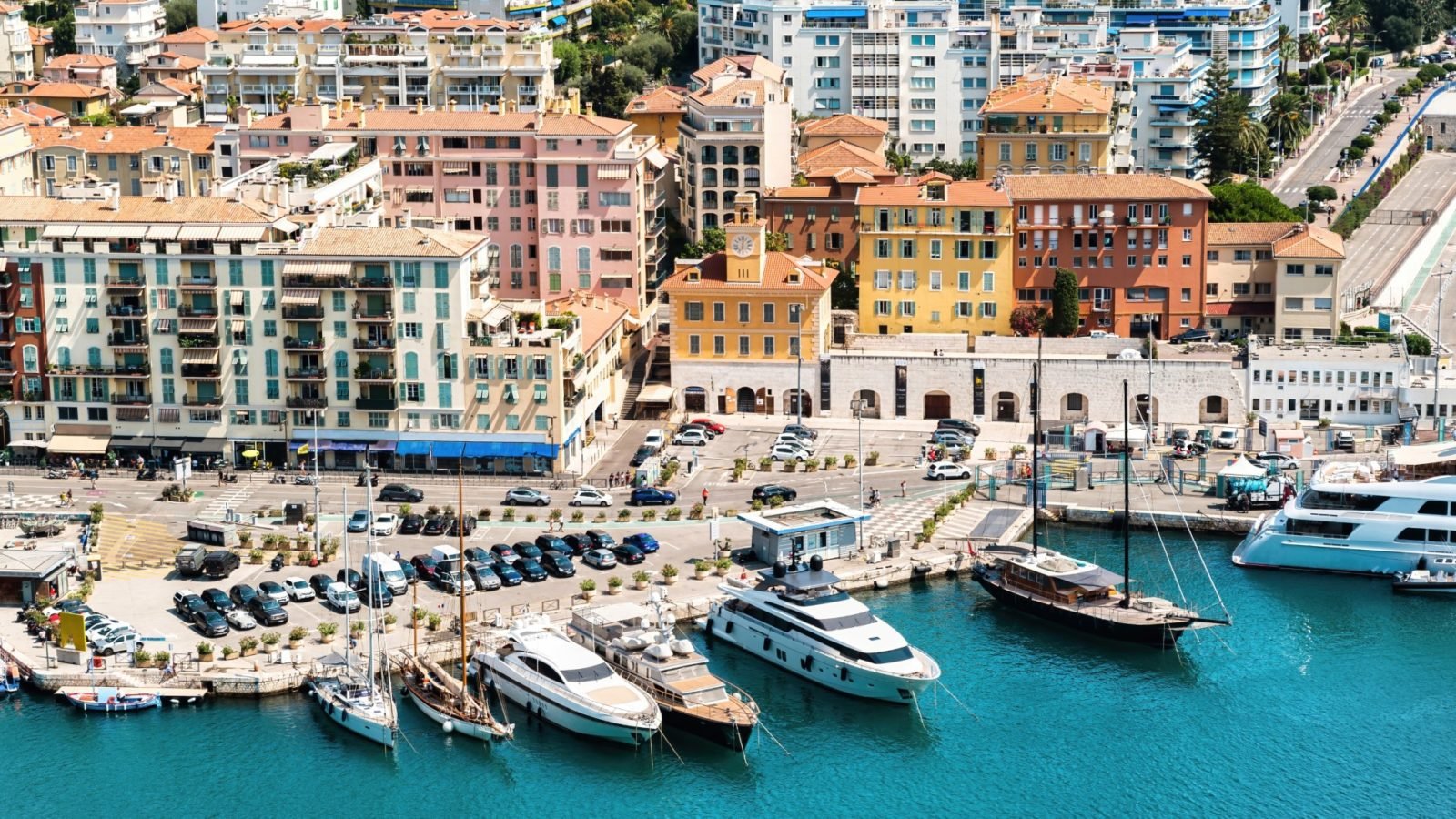The French Riviera, also known as the Côte d’Azur, is a breathtaking region on the southeastern coast of France. With its stunning beaches, charming villages, and world-class cuisine, the French Riviera is a dream destination for many travelers. Families will enjoy water sports, amusement parks, and museums, making it an excellent destination for families with children of all ages. Additionally, the region offers plenty of delicious food and cultural experiences for parents to enjoy, ensuring a memorable family vacation for all. In this 5-day French Riviera itinerary to consider for your France family holiday, we’ll show you the best things to do, see, eat, and where to stay during your trip.
Day 1: Nice
Things to Do with Kids:
- Visit the Promenade des Anglais, a long seaside promenade where you can walk, bike, or rollerblade while enjoying the stunning view of the Mediterranean Sea.
- Visit Nice Castle Hill, which offers panoramic views of the city and the coastline.
- Visit the Parc Phoenix, a botanical garden and zoo where you can see animals from all over the world.
What to See:
- Explore the Old Town of Nice, with its colorful houses, narrow streets, and numerous restaurants and cafes.
- Visit the Cathedrale Sainte-Reparate, a Baroque-style cathedral that dates back to the 17th century.
- Visit the Musée Matisse, a museum dedicated to the works of the famous French artist Henri Matisse.
Where to Stay:
- Hotel La Pérouse, a 4-star hotel with a great location and stunning views of the sea.
- Hotel Negresco, a historic 5-star hotel that has been welcoming guests since 1913.
Where to Eat:
- La Petite Maison, a restaurant that serves traditional French cuisine in a cozy atmosphere.
- Chez Acchiardo, a family-owned restaurant that serves Niçois specialties such as socca and pissaladière.
Day 2: Cannes
Things to Do with Kids:
- Visit the Cannes Film Festival Palace, where you can take a tour of the iconic venue and learn about the history of the festival.
- Visit the Îles de Lérins, a group of islands off the coast of Cannes where you can swim, snorkel, and explore the beautiful landscapes.
- Visit the Musée de la Mer, a museum dedicated to the marine life of the region.
What to See:
- Explore the Croisette, a seaside promenade lined with luxury shops, hotels, and restaurants.
- Visit the Notre-Dame de Bon Voyage, a beautiful church that dates back to the 19th century.
- Visit the Castre Museum, a museum located in a medieval castle that houses collections of art and ethnography.
Where to Stay:
- Hotel Barrière Le Majestic Cannes, a 5-star hotel located on the Croisette with a private beach and luxury amenities.
- Hotel Martinez, a 5-star hotel that has been welcoming guests since 1929 and features elegant Art Deco decor.
Where to Eat:
- La Palme d’Or, a Michelin-starred restaurant that offers contemporary French cuisine and an exceptional wine list.
- Le Bistrot Gourmand, a cozy restaurant that serves traditional French cuisine with a modern twist.
Day 3: Saint-Tropez
Things to Do with Kids:
- Visit the Plage de Pampelonne, a long sandy beach where you can swim, sunbathe, and enjoy water sports.
- Visit the Château de la Moutte, a beautiful castle surrounded by gardens that offer a peaceful escape from the hustle and bustle of the town.
- Visit the Annonciade Museum, a museum dedicated to modern and contemporary art.
What to See:
- Explore the old town of Saint-Tropez, with its charming narrow streets, colorful houses, and numerous boutiques, cafes, and restaurants.
- Visit the Citadelle de Saint-Tropez, a fortress built in the 17th century that offers a panoramic view of the town and the sea.
- Visit the Saint-Tropez Market, where you can find local products such as cheese, olives, fruits, and vegetables.
Where to Stay:
- Hotel de Paris Saint-Tropez, a 5-star hotel located in the heart of the town with a rooftop pool and a spa.
- Villa Marie Saint-Tropez, a 5-star hotel located in a tranquil setting with a beautiful garden and a swimming pool.
Where to Eat:
- La Vague d’Or, a 3-Michelin-starred restaurant that offers refined Mediterranean cuisine and a stunning view of the sea.
- Le Club 55, a beachfront restaurant that has been a hotspot for celebrities since the 1950s and serves fresh seafood and salads.
Day 4: Antibes
Things to Do with Kids:
- Visit Marineland, a marine park that features dolphins, killer whales, sea lions, and other aquatic animals.
- Visit the Picasso Museum, a museum dedicated to the works of the famous artist Pablo Picasso.
- Visit the Musée Peynet et du Dessin Humoristique, a museum dedicated to the works of the French cartoonist Raymond Peynet.
What to See:
- Explore the Old Town of Antibes, with its charming narrow streets, colorful houses, and numerous shops, cafes, and restaurants.
- Visit Fort Carré, a fortress built in the 16th century that offers a panoramic view of the sea and the coastline.
- Visit the Cap d’Antibes, a scenic peninsula that features beautiful beaches, luxury villas, and lush vegetation.
Where to Stay:
- Hotel Belles Rives, a 5-star hotel located in a historic Art Deco building with a private beach and a restaurant that has been awarded a Michelin star.
- Hotel Juana, a 4-star hotel located in the heart of Juan-les-Pins with a swimming pool and a spa.
Where to Eat:
- Les Vieux Murs, a restaurant that serves creative Mediterranean cuisine in a charming setting.
- Le Figuier de Saint-Esprit, a restaurant that has been awarded a Michelin star and serves refined French cuisine with a Provençal touch.
Day 5: Monaco
Things to Do with Kids:
- Visit the Oceanographic Museum, a museum dedicated to marine life that features a shark lagoon, a turtle pool, and numerous interactive exhibits.
- Visit the Jardin Exotique, a botanical garden that features a collection of exotic plants from all over the world.
- Visit the Prince’s Palace, the residence of the Prince of Monaco that dates back to the 13th century.
What to See:
- Explore the Monte-Carlo district, with its luxurious shops, hotels, and casinos.
- Visit the Saint Nicholas Cathedral, a beautiful church that features impressive stained glass windows and the tombs of the Grimaldi family.
- Visit the Monaco Grand Prix Circuit, a famous Formula One track that passes through the streets of Monte-Carlo.
Where to Stay:
- Hotel Hermitage Monte-Carlo, a 5-star hotel located in a historic Belle Epoque building with a spa and a Michelin-starred restaurant.
- Hotel Metropole Monte-Carlo, a 5-star hotel located in the heart of Monte-Carlo with a private beach and a 2-Michelin-starred restaurant.
Where to Eat:
- Louis XV – Alain Ducasse, a 3-Michelin-starred restaurant that offers an exceptional dining experience
- Yoshi, a 1-Michelin-starred restaurant that offers contemporary Japanese cuisine in a stylish setting.
What to Wear on the French Riviera
The French Riviera has a reputation for being a stylish destination, so it’s important to dress appropriately. Here are some tips on what to wear during your French Riviera itinerary in 5 days:
- Dress for the season: The French Riviera has a mild Mediterranean climate, so it’s generally warm and sunny. In the summer months, lightweight clothing such as cotton or linen is best, while spring and fall may require a light jacket or sweater for cooler evenings.
- Keep it stylish: The French Riviera is known for its fashionable style, so it’s best to dress stylishly. Think casual-chic and avoid anything too casual or too revealing.
- Comfortable footwear: As you walk around and explore, comfortable footwear is essential. Sneakers, loafers, sandals, or flats are all great options.
- Beachwear: If you plan on spending time at the beach or pool, pack your swimsuits, cover-ups, and flip-flops.
- Dress for dinner: Many restaurants have dress codes, especially for dinner. Men should consider wearing collared shirts and dress pants, while women can opt for dresses or skirts.
- Accessories: Don’t forget to bring sunglasses, a sunhat, and a lightweight scarf for the cooler evenings.
Overall, the key is to dress stylishly yet comfortably for the warm weather and the casual-chic atmosphere of the French Riviera.
When to Go to the French Riviera
The French Riviera has a Mediterranean climate, which means that it’s generally warm and sunny all year round. However, the best time to go to the French Riviera depends on your preferences and what you plan to do. Here’s a breakdown of the different seasons and what to expect:
- Spring (March – May): This is a great time to visit if you prefer mild weather and smaller crowds. The temperatures are typically in the 60s to low 70s (Fahrenheit), making it perfect for outdoor activities like hiking and exploring the coastal towns.
- Summer (June – August): This is the high season in the French Riviera, with the warmest weather and the largest crowds. Temperatures can reach up to the mid-80s, making it perfect for beachgoers and water sports enthusiasts. Keep in mind that prices for accommodation and activities may be higher during this season.
- Fall (September – November): The weather is still mild in the fall, with temperatures ranging from the 60s to low 70s. This is a great time to visit if you want to avoid the crowds and enjoy the changing colors of the foliage.
- Winter (December – February): The winter months in the French Riviera are mild, with temperatures in the 50s to low 60s. While not ideal for swimming or beach activities, this is a great time to enjoy the cultural attractions and events, such as the Christmas markets and the Nice Carnival.
Overall, the French Riviera is a great destination to visit year-round, but the best time to go depends on your preferences and what you plan to do.
How to Get Around the French Riviera
There are several ways to get around the French Riviera, depending on your budget, travel style, and itinerary. Here are some options:
- Car rental: Renting a car is a great way to explore the French Riviera at your own pace and on your own schedule. There are several rental car companies located at the major airports and train stations, and the region has a good network of highways and local roads.
- Public transportation: The French Riviera has a reliable and affordable public transportation system, which includes buses and trains. The regional train network, known as TER (Transport Express Régional), connects the major towns and cities along the coast. At the same time, the local bus system provides access to smaller villages and beaches.
- Taxis and private transfers: Taxis are readily available throughout the French Riviera, and you can also arrange for private transfers or chauffeur services. This option is more expensive than public transportation but can be convenient for shorter trips or for getting to and from the airport.
- Bike rental: The French Riviera is also a great destination for cycling, with several bike rental companies and dedicated bike paths. This is a fun and eco-friendly way to explore the region, and you can cover more ground than walking.
- Walking: Many of the towns and villages in the French Riviera are small and pedestrian-friendly, making walking a great option for getting around. This is especially true in the old town areas of cities like Nice and Antibes, where narrow streets and historic buildings create a charming ambiance.
Overall, the best way to get around the French Riviera depends on your preferences and itinerary, but renting a car or using public transportation are the most popular options.
How Much to Travel to the French Riviera
The cost of your travel based on this French Riviera itinerary in 5 days can vary widely depending on your travel style, and the time of year you visit. Here are some general estimates of the costs:
- Accommodation: The cost of accommodation in the French Riviera can range from budget-friendly hostels and guesthouses to luxury hotels and resorts. On average, you can expect to pay around €50-€100 per night for a mid-range hotel or rental apartment, while high-end hotels can cost €200 or more per night.
- Food and drinks: The French Riviera is known for its cuisine, but dining out can be expensive, especially in tourist areas. A mid-range restaurant meal for one person can cost around €20-€30, while a three-course meal for two with wine can cost around €80-€100. However, there are also many local markets, bakeries, and food stalls where you can find more affordable meals and snacks.
- Transportation: The cost of transportation in the French Riviera depends on your mode of travel. Renting a car can cost around €50-€100 per day, while using public transportation is more affordable, with a single bus or train ride costing around €1.50-€2. Taxis and private transfers are more expensive, with a taxi ride from Nice to Cannes costing around €80-€100.
- Activities and attractions: There are many things to see and do in the French Riviera, from exploring museums and historic sites to enjoying outdoor activities like hiking and water sports. Admission fees for museums and attractions can range from €5-€20 per person, while outdoor activities and tours can cost more.
Overall, a budget-friendly trip to the French Riviera can cost around €100-€150 per day per person, while a mid-range trip can cost around €200-€300 per day per person, and a luxury trip can cost €500 or more per day per person. However, costs can vary widely depending on your choices and preferences, so it’s important to research and plan your trip accordingly.




